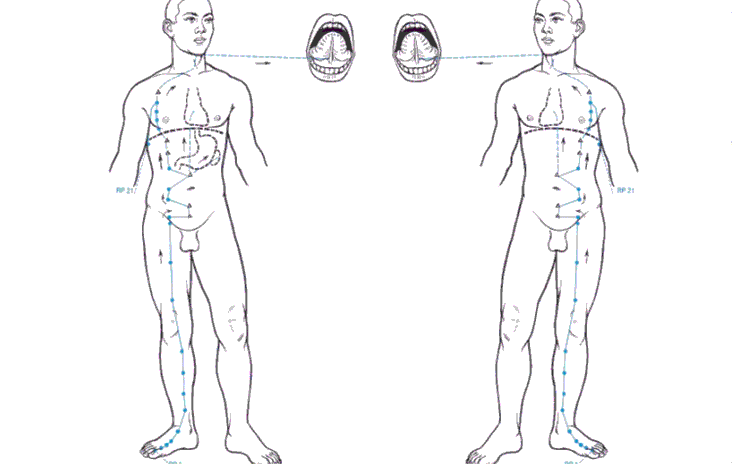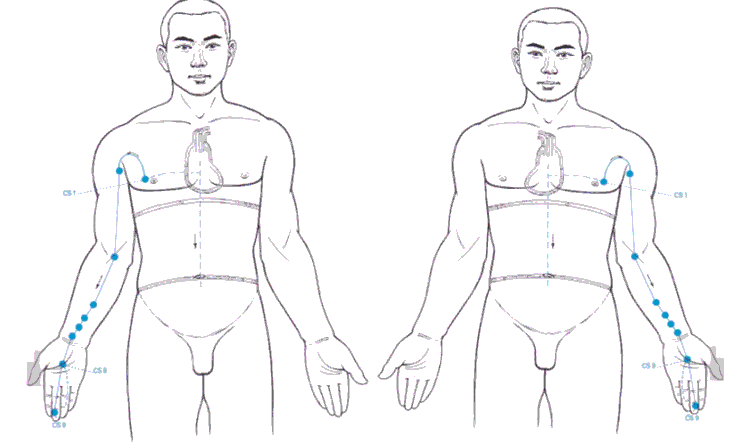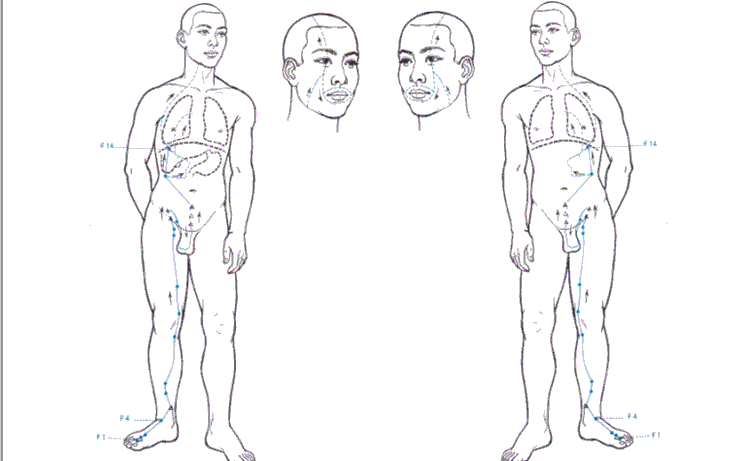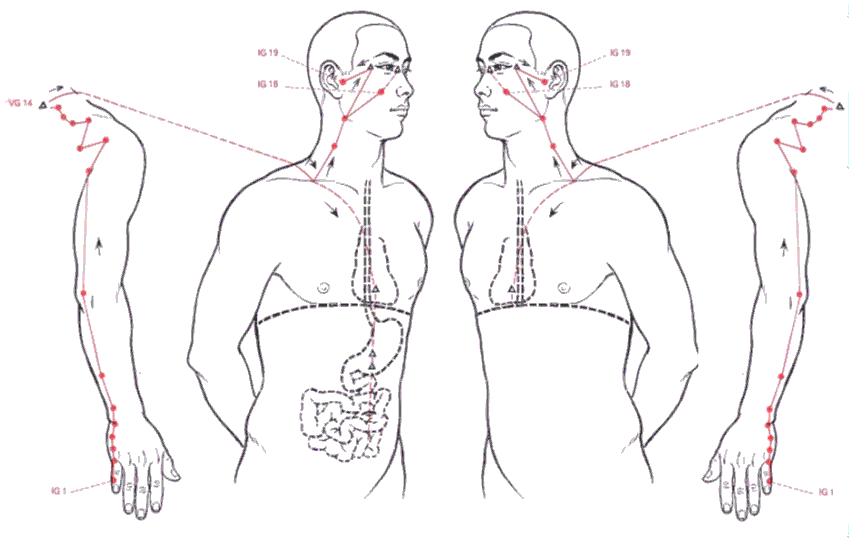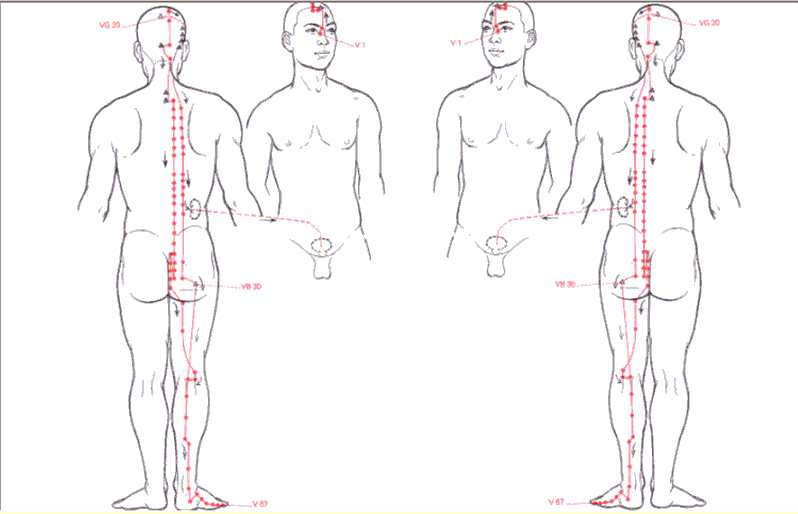| Blog | Home | About Us | Editor's Note | Contact Us | Health Topics | Products | |
||
|
|
||
|---|---|---|
Meridian Channels |
||
|
Arm Tai Yin Lung Channel (peak time: 3am ~ 5am) The Lung Meridian originates in the middle portion of the body, and runs downwards connecting with the large intestine. It then turns and passes through the diaphragm to connect with the lungs. This meridian branches out from the axilla (armpit) and runs down the medial aspect of the upper arm where it crosses the elbow crease. It continues until it passes above the major artery of the wrist, and emerges at the tip of the thumb. Another branch emerges from the back of the wrist and ends at the radial side of the tip of the index finger to connect with the Large Intestine Meridian. The Lungs govern Qi. They take in clear and expel the turbid air. The Lungs regulate the waterways. Fluid secretion is sweat. The Lungs govern the skin’s surface and body hair. They house the Po. The peak time for the Lungs is from 3~5am. - Sensitivity, cough, asthma, blocked nose, headache, pains in the shoulders and back, pains in the arms
Leg Tai Yin Spleen Meridian (peak time: 9am ~ 11am) The Spleen Meridian begins at the big toe and runs along the inside of the foot crossing the inner ankle. It then travels along the inner side of the lower leg and thigh. Once it enters the abdominal cavity, it internally connects with the spleen and continues upward to reach the Heart Meridian. Externally, the Spleen Meridian continues moving toward the chest and branches out to reach the throat and the root of the tongue. The peak time for the Spleen is 9-11am - Stiffness and pain of the tongue, gastric pain, meteorism, vomiting, jaundice, geneal weakness and feeling heavy
Arm Shao Yin Heart Meridian (Peak time: 11am ~ 1pm) The Heart Meridian starts from the heart, and divides into three branches. One goes towards the small intestine. The second runs upwards along the throat towards the eyes, and the third branch emerges under the arm and runs along the inner side of the forearm, elbow and upper arm. It then crosses the inner side of the wrist and palm and ends at the inside tip of the little finger, where it connects with the Small Intestine Meridian. The peak time for the Heart is from 11 am–1 pm. - Dry throat, pain in the region of the heart of hypochondria, headaches with painful eyes, pains in the back, thirst, jaundice, hot palms
Leg Shao Yin Kidney Meridian (peak time: 5pm ~ 7pm) The Kidney Meridian starts from the inferior side of the small toe. Crossing the middle of the sole and the arch of the foot, it circles behind the inner ankle and travels along the innermost side of the lower leg and thigh, until it enters the body near the base of the backbone. After connecting with the kidney, it comes out at the pubic bone. Over the abdomen, it runs externally upwards until it reaches the upper part of the chest (the inner side of clavicle). A second branch emerges from the kidney and moves internally upwards and passes through the liver, diaphragm, lungs and throat, finally terminating at the root of the tongue. Another small branch divides from the lung to connect with the heart and the pericardium. The peak time for the Kidneys is from 5-7pm. Symptoms: - Lumbar back pain and at the base of the back, cold feet, haemoptysis, dyspnoea, dry tongue, sore throat, lumbago, oedema, constipation, diarrhoea, motor paralysis and msucle atrophy of the lower limbs, hot plantar side of the foot and pain along the pathway of the meridian
Arm Jueyin Pericardium Meridian (peak time: 7pm ~ 9pm) The Pericardium is also called the "heart protector," and, for clinical purposes, is considered a yin organ paired with the yang organ San Jiao. In general theory, the Pericardium is not distinguished from the Heart. It is also the first line of defence against the Heart from External Pathogenic Influences. The Pericardium has a meridian named for it, which reflects the health of the organ. In terms of the Five Elements, these organs are both associated with the fire element. In treatment, it is often best to approach heart problems via the Pericardium, rather than directly. The peak time for the Pericardium is from 7pm to 9pm. - Chest fullness, palpitation, irritabiity and agitation, spasm and contracture of the elbow and arm, hot palm and pain along the pathway of the meridian, stiff head and neck
Leg Jue Yin Liver Meridian (peak time: 1am ~ 3am) The Liver Meridian starts from the top of the big toe and goes across the top of the foot. After crossing the inner ankle, it continues to go upwards along the inner side of the lower leg and the thigh, until it reaches the pubic region. It then circulates around the external genitalia and enters the lower abdomen. Afterwards, it goes up the abdomen and reaches the lower chest to connect with the liver and gall bladder. The meridian further travels upwards along the throat and connects with the eyes. Finally it emerges from the forehead to reach the vertex of the head. One of its internal branches originates internally from the eye and moves downwards to the cheek where it curves around the inner surface of the lips. Another branch starts from the liver and passes through the diaphragm to reach the lung where it connects with the Lung Meridian and completes the cycle of the twelve meridians. The peak time for the liver is between 1am ~ 3am.
Arm Tai Yang Small Intestine Meridian (peak time: 1pm ~ 3pm) The Small Intestine Meridian starts from the tip of the little finger and crosses the palm and wrist. It runs upwards along the posterior side of the forearm until it reaches the back of shoulder where it ends at the uppermost part of the back (the bottom of the neck). At this position, it first branches off and moves internally through the heart and stomach to reach the small intestine. The second branch travels externally across the neck and cheek until it reaches the outer corner of the eye and then enters the ear. A short branch in the cheek moves upward to the inner corner of the eye where it connects with the Bladder Meridian.
Leg Tai Yang Bladder Meridian (peak time: 3pm ~ 5pm) The Bladder Meridian starts at the inner side of the eye and goes across the forehead to reach the top of the head where it branches into the brain. The main channel then goes across the back of the head and divides into two branches. One branch crosses the center of the base of the neck and extends downwards parallel to the spine. Once in the lumbar region (bottom of the spine), it branches out to reach the bladder. The other branch crosses the back of the shoulder and runs downward on the outside, which is adjacent and parallel to the inner branch. It continues down until it reaches the buttocks where two branches run across the back of thigh along different pathways that join at the back of the knee. The joint meridian then continues along the back of the lower leg, circles behind the outer ankle, runs along the outside of the foot and terminates on the lateral side of the tip of the small toe, where it connects with the Kidney Meridian.
Arm Shao Yang Triple Heater Meridian (peak time: 9pm ~ 11pm) The Triple Heater Meridian begins at the outer tip of the ring finger and goes along the back of the hand, wrist, forearm and upper arm, until it reaches the shoulder region where it branches off. One branch travels internally into the chest and passes through the pericardium and diaphragm uniting the upper, middle and lower heater (triple heater). The other branch runs externally up the side of the neck, circles the ear and face, and finally ends at the outer end of the eyebrow where it connects with the Gall Bladder Meridian.
Leg Shao Yang Gall Bladder Meridian (peak time: 11pm ~ 1am) The Gall Bladder Meridian starts from the outer corner of the eye and divides into two branches. One branch runs externally and weaves back and forth at the lateral side of the head. After curving behind the ear, it reaches the top of the shoulder and crosses the lateral side of rib cage and abdomen, until it ends up at the side of the hip. The other branch enters the cheek and runs internally downward, through the neck and chest to connect with the gall bladder. It continues moving downwards and comes out in the lower abdomen, where it connects with the other branch at the hip. The hip branch then runs toward the lateral side of the thigh and lower leg. After crossing the ankle, it goes over the foot to reach to the tip of the fourth toe. Another small branch leaves the meridian and terminates at the big toe to connect with the Liver Meridian.
Arm Yang Ming Large Intestine Meridian (peak time: 5am ~ 7am) The Large Intestine Meridian starts from the tip of the index finger and runs between the thumb and the index finger. It then proceeds along the lateral side of the forearm and the anterior side of the upper arm, until it reaches the highest point of the shoulder. From there, it has two branches. One goes internally towards the lungs, diaphragm and large intestine. The other travels externally upwards where it passes the neck and cheek, and enters the lower teeth and gums. It then curves around the upper lip and crosses to the opposite side of the nose.
Leg Yang Ming Stomach Meridian (peak time: 7am ~ 9am) The Stomach Meridian starts from the end of the Large Intestine Meridian at the side of the nose, and passes through the inner corner of the eye to emerge from the lower part of the eye. Going downwards, it enters the upper gum and curves around the lips and lower jaw. It then turns upwards, passing in front of the ear, until it reaches the corner of the forehead where it splits into an internal and external branch. The internal branch emerges from the lower jaw, running downwards until it reaches its pertaining organ, the stomach. The external branch crosses the neck, chest, abdomen and groin where it goes further downward along the front of the thigh and the lower leg, until it reaches the top of the foot. Finally, it terminates at the lateral side of the tip of second toe. Another branch emerges from the top of the foot and ends at the big toe to connect with the Spleen Meridian.
|
||
Home |
||


